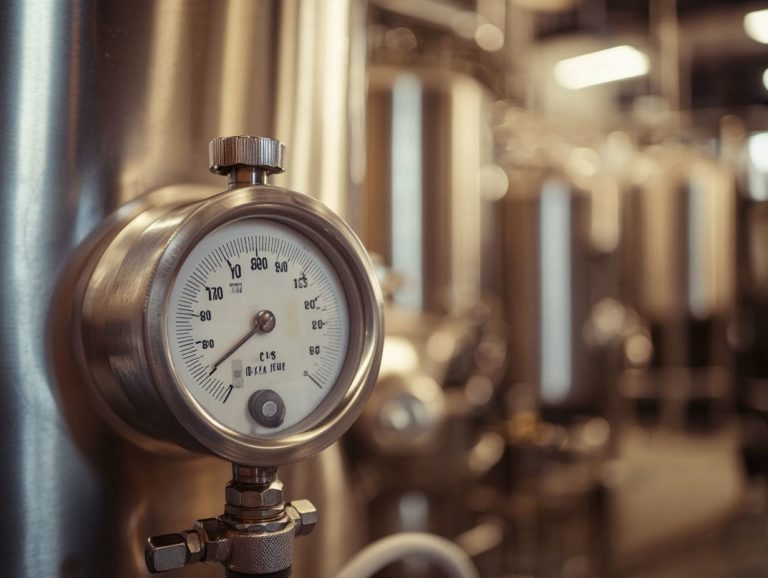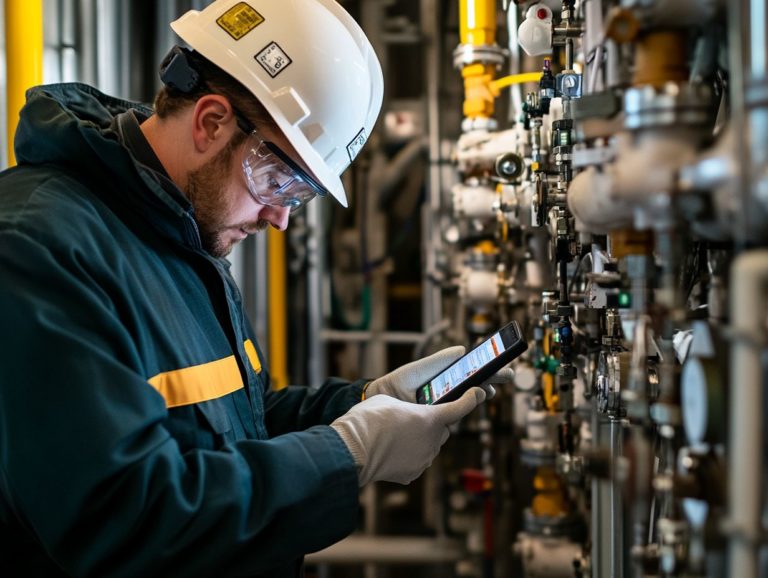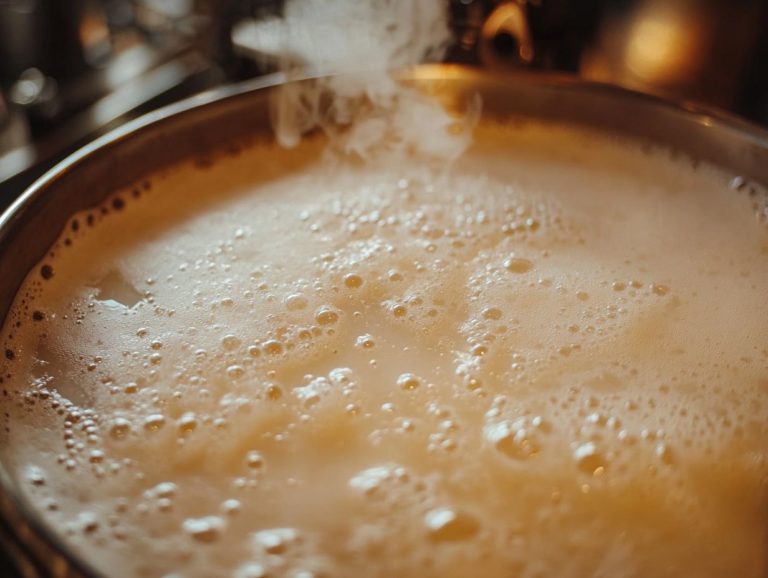How to Fix Cloudy Home Brew
Home brewing is a rewarding pursuit, yet it occasionally presents unexpected challenges, such as that frustrating cloudiness in your beer that just doesn t look as inviting as it should. This cloudiness, often referred to as haze, can be a byproduct of various factors in the brewing process, including yeast activity and polyphenols.
If you ve found yourself pondering how to clear up that haze, you re in the right spot. This article will guide you through a range of methods to rectify cloudy home brews, including the cold crash technique, chilling, and the use of fining agents.
You ll also learn how to detect and prevent infections in your brew, ensuring that you savor a crisp, clean beverage every single time. Proper sanitation and temperature control during fermentation are key.
Dive in as you uncover the secrets to brewing perfection!
Contents
- Key Takeaways:
- How to Fix Cloudy Home Brew?
- 3. Filtering
- 4. Re-Boiling and Re-Fermenting
- How to Tell if Your Home Brew is Infected?
- 2. Use of Airlocks
- 3. Avoiding Contaminated Equipment
- 4. Proper Storage and Temperature Control
- Frequently Asked Questions
- Is there a way to prevent cloudiness in home brew?
- Can I still drink cloudy home brew?
Key Takeaways:

- Use the cold crash method to fix cloudy home brew – simply lower the temperature to cause sediment to drop to the bottom.
- Fining agents can also be used to clarify home brew, such as gelatin, isinglass, or Irish moss. These agents help reduce protein haze and improve the overall clarity of your beer.
- Filtering can be an effective way to remove particles, sediment, and improve clarity, but be careful not to remove too much yeast. Using a filter with a rating of 1.0 micron is ideal.
How to Fix Cloudy Home Brew?
Cloudy homebrew can be a source of frustration for those who envision their beer with a clear and enticing appearance. Several factors can contribute to this cloudiness, such as insufficient fermentation, protein haze, polyphenols, and lingering residual sugars that persist after brewing.
By understanding these elements, alongside techniques like cold crashing and incorporating finings such as Irish moss, you can achieve the clarity you desire in your homebrew. Furthermore, effectively managing trub, temperature, and CO2 levels during the kegging process can significantly enhance the final product s visual appeal.
1. Cold Crash Method
The cold crash method is a highly regarded technique in the brewing process that involves lowering the temperature of your beer after fermentation. This approach promotes yeast flocculation and sedimentation, enhancing clarity and minimizing protein haze. This technique is particularly effective for removing chill haze and improving the final pour.
To execute this method successfully, you ll want to lower the beer’s temperature to around 32 F to 36 F (0 C to 2 C) for about 24 to 48 hours. This significant temperature drop encourages the yeast and any suspended particles to settle effectively at the bottom of your fermentation vessel.
The advantages of cold crashing go beyond just improved clarity; it also impacts the overall flavor profile and mouthfeel of your final product by allowing unwanted flavors and compounds to be eliminated.
For optimal results, consider using a fermentation chamber, a temperature controller, or a large refrigerator to ensure precise temperature management during this crucial phase of brewing.
2. Fining Agents
Fining agents, such as Irish moss, are critical tools for you as a brewer, allowing you to reduce protein haze and enhance the clarity of your homebrew. These agents work by binding to haze-forming particles, facilitating their removal and resulting in a cleaner pour. Additionally, finings help to settle out trub and other unwanted materials.
They operate through various mechanisms: some, like gelatin and bentonite, attract and settle out undesirable components, while Irish moss, a type of seaweed, plays a key role in coagulating proteins during the boiling process. These agents are vital in the brewing process for achieving clarity.
When you compare Irish moss to other fining options, it s essential to take into account the specific beer styles you’re working with. For example, hefeweizens typically benefit less from fining due to their signature cloudiness, whereas lagers and pale ales can achieve a stunning brilliance when these agents are applied effectively. Each style requires different brewing techniques and fining agents to achieve optimal clarity.
To truly maximize clarity in your brew, timing is everything. Incorporating these fining agents during the last 10 to 15 minutes of the boil is crucial, as this allows them to interact with haze-forming proteins and expedite their removal during fermentation.
3. Filtering
Filtering is an essential step in the kegging process that can significantly enhance the clarity of your beer. By employing filters with a rating as fine as 1.0 micron, you can effectively remove lingering particles, sediment, and haze-forming elements that might detract from the final product. This method is especially useful for eliminating chill haze caused by polyphenols and proteins.
In the realm of homebrewing, you ll find a variety of filtering systems tailored to accommodate different fermentation styles and preferences. Cartridge filters, such as 10 cartridges, are particularly popular for their effectiveness in polishing off your brew. Meanwhile, depth filters excel in handling larger volumes, offering a more robust filtration solution.
Timing plays a crucial role; filtering right before kegging is ideal for catching those last-minute impurities. It s imperative to maintain a high level of sanitation during this phase and use proper keg connectors to mitigate any risk of contamination that could spoil your hard work. Monitoring the keg pressure ensures that your beer maintains the desired carbonation level. Each sip should be an absolute delight, so make sure you get this step right!
4. Re-Boiling and Re-Fermenting

Re-boiling and re-fermenting your homebrew can be an effective strategy for tackling cloudiness caused by excessive residual sugars that haven t fully fermented. This allows for additional yeast activity to clarify your beer and helps eliminate any polyphenols that may contribute to haze.
This process involves carefully heating the beer to a controlled temperature, typically between 160 F and 180 F. This step helps drive off unwanted volatile compounds before you transition back to fermentation. As you adjust the fermentation time, it s essential to monitor the specific gravity (the measure of sugar content that helps indicate fermentation progress) regularly, ensuring the yeast remains viable and active without overwhelming it.
The choice of specific yeast strains can greatly impact the final flavor profile. Different strains introduce unique esters and phenols that enhance complexity while promoting clarity. By maintaining consistent temperature control during re-fermentation, you can achieve a more polished product, free from undesirable haze, ensuring your homebrew reaches its desired taste and appearance. Using a quality fermentation chamber or immersion cooling system can help maintain the right temperature.
How to Tell if Your Home Brew is Infected?
Act quickly! Detecting infection early is crucial to maintaining the quality of your brew. You can often identify potential issues through various signs, such as off-putting aromas that might remind you of spoiled food, sour or vinegar-like tastes, and unusual changes in color and texture. Monitoring the gravity can also provide clues to potential problems. Paying attention to these indicators will help you ensure that your brew remains exceptional.
1. Off-Flavors and Odors
One of the most obvious indicators of infection in your homebrew is the emergence of off-flavors and unpleasant odors that can dramatically alter the flavor profile you were aiming for. This often happens due to unwanted yeast or bacteria sneaking in during fermentation. Using proper brewing equipment and maintaining strict sanitation protocols can mitigate these risks.
Be on the lookout for common off-flavors like diacetyl, which manifests as a buttery aroma, and various phenolic characteristics that may remind you of clove or that unwelcome bandaid scent. These pesky compounds usually come from bacteria such as Pediococcus or Lactobacillus and can be worsened by less-than-ideal sanitization practices. Ensuring proper kegging techniques and using dextrose for priming can also help mitigate these issues.
To identify these odors, you ll need a discerning nose. For example, while diacetyl might evoke memories of movie theater popcorn, phenolic notes can be quite pronounced, cutting through the typical fermentation aromas. It’s essential to differentiate these from the usual fermentation byproducts like esters and subtle alcohol scents. Using a hop bag during the brewing process can also help manage the aroma profile.
Those unwanted flavors can complicate your tasting experience and may signal deeper issues in your brewing process.
2. Changes in Color and Texture
Changes in color and texture of your homebrew can serve as unmistakable indicators of potential infection. If you notice unexpected cloudiness or dull hues, it s a signal that something might have gone awry during the brewing or fermentation process. Regularly monitoring the specific gravity, which measures the density of your brew and is crucial for monitoring fermentation progress, can provide early warnings of issues.
Take, for example, a vibrant golden ale that s supposed to radiate clarity and brightness. If it suddenly adopts a murky or dingy appearance, that s a red flag it could mean spoilage organisms are at play. Subtle shifts toward darker shades may also suggest oxidation or contamination, which can detract from the flavor profile you were aiming for. Using nitrogen instead of CO2 can sometimes reduce the risk of oxidation.
Texture is equally important; if you spot a slick film forming on the surface or unusual sediment settling at the bottom, these are often signs of unwanted bacteria or wild yeast strains. For best results, ensure that your bottle conditioning process is meticulously followed to avoid such issues.
Such changes in consistency can disrupt the mouthfeel and overall enjoyment of your brew, leading to less-than-satisfying sips. By understanding these signs, you can identify the root causes and take corrective measures to restore the quality you desire in your homebrew. Always pour slowly to minimize the disturbance of any sediment.
3. Mold or Scum Growth
The presence of mold or scum growth on the surface of your homebrew is one of the most alarming signs of infection, indicating that wild yeast or pesky bacteria have invaded your brew! Proper mashing techniques and the use of high-quality brewing equipment can significantly reduce this risk.
These unsightly growths can manifest in various colors, ranging from green and black to white and fuzzy, depending on the specific type of mold or yeast at play. Scum, in contrast, usually appears as a film or oily layer that not only disrupts the brewing process but also negatively affects the flavor. Different microorganisms can introduce unique off-flavors and aromas, drastically altering the quality of your beer. Visiting your local brew shop for expert advice can help you identify and resolve these issues effectively.
To prevent these unwanted intruders, it s essential to uphold rigorous sanitation practices throughout your brewing journey. By regularly cleaning all your equipment and maintaining a controlled environment, you lower the chances of getting contaminants, ensuring a pristine and healthy brewing atmosphere.
How to Prevent Infection in Homebrew?

Preventing infection in your homebrew is crucial for crafting high-quality beer, and it all starts with meticulous sanitation practices. You ll want to effectively utilize airlocks and ensure that all your brewing equipment is free from contaminants and stored at optimal temperatures.
Pay attention to these details to set the stage for a superior brewing experience.
1. Proper Sanitization
Properly sanitizing all your brewing equipment is not just a suggestion; it s a vital step in warding off infection. Even the tiniest speck of residue or bacteria can wreak havoc on fermentation, resulting in undesirable off-flavors in your homebrew.
Using different cleaning methods is essential to ensure that every piece of brewing gear, from fermenters to bottles, is thoroughly disinfected. Common practices include soaking items in a solution of unscented bleach diluted with water or using no-rinse sanitizers like Star San, which are popular for their simplicity and effectiveness.
In terms of cleaning fermenters, bottles, and kegs, take the time to scrub surfaces thoroughly to eliminate any organic matter before applying your sanitizing solution. Timing is everything; allowing the sanitizer to sit for the duration specified in its instructions is crucial, as this ensures that the agents can effectively tackle potential contaminants.
Keep in mind that a clean brewing setup cultivates a healthy fermentation environment leading to better beer. Your attention to detail in sanitization can make all the difference in your brewing success.
2. Use of Airlocks
Using airlocks during fermentation is a crucial step in safeguarding against infection. These devices allow CO2 to escape while keeping contaminants at bay, creating a pristine environment for your yeast to thrive.
Think of airlocks as your fermentation’s protective shield. They foster a healthy atmosphere essential for achieving top-notch results in brewing or winemaking. You’ll find a variety of airlocks to choose from, including traditional S-shaped locks, blow-off tubes, and single-valve systems. Each type has unique features tailored for specific fermentation needs.
To use them properly, fill the lock with clean water or vodka, securely attach it to your fermentation vessel, and ensure it stays sealed throughout the process. Regularly check for bubbling activity and cleanliness to avoid any potential blockages.
If you notice a lack of bubbles, inspect for leaks and confirm that fermentation is actively progressing.
3. Avoiding Contaminated Equipment
Avoiding contaminated equipment is essential for maintaining the integrity of your homebrew. Even a tiny encounter with bacteria or wild yeast can ruin an entire batch.
Watch for signs of contamination to keep your brew safe and delicious! Look out for any unusual odors, unexpected color shifts, or sediment that shouldn t be there.
Regular maintenance ensures your brewing equipment stays clean and in excellent working order. Rinse out your tools right after use, and don t skimp on sanitization before each brewing session to reduce the risk of contamination. Storing your equipment in a clean, dry place will help keep unwanted microorganisms at bay.
When handling your gear, always use the right tools for specific tasks and take care to avoid cross-contamination by keeping clean and dirty items separate throughout the brewing process.
4. Proper Storage and Temperature Control
Implementing proper storage techniques and maintaining precise temperature control is essential for preventing infection in your homebrew. Fluctuations in temperature can foster the unwelcome growth of bacteria and yeast, turning your masterpiece into a misadventure.
For most ales, the ideal fermentation temperature typically hovers between 65 F (18 C) and 75 F (24 C), while lagers prefer a cooler environment, around 45 F (7 C) to 55 F (13 C). During these critical brewing stages, ensuring a stable environment is key to achieving a clean fermentation and allowing optimal flavor development.
Regularly check the temperature of your fermentation vessel with reliable thermometers or temperature probes, as drastic shifts can stress the yeast and sabotage your efforts.
Utilizing insulated fermentation containers or dedicated brewing fridges can greatly enhance your ability to manage temperature stability, significantly reducing the risk of off-flavors and ensuring the integrity of your final product.
Frequently Asked Questions

What causes home brew to become cloudy?
Cloudiness in home brew can be caused by a variety of factors, including the presence of suspended yeast particles, excess protein, and certain brewing practices like not properly filtering or cold crashing the beer.
How can I fix cloudy home brew?
One way to fix cloudy home brew is to allow the beer to cold crash in the fermenter before bottling or kegging. This process helps the yeast and other particles settle to the bottom, resulting in a clearer beer.
What is the best way to cold crash my home brew?
The best way to cold crash your home brew is to transfer it to a separate container, such as a carboy or keg, and store it in a cold environment (around 35-40 F or 1-4 C) for a few days. This will cause the particles to settle and the beer to become clearer.
Can I use fining agents to fix cloudy home brew?
Yes, fining agents such as gelatin or Irish moss can be used to clarify home brew. These agents help to bind with the particles in the beer and sink them to the bottom, resulting in a clearer brew.
Is there a way to prevent cloudiness in home brew?
Yes, you can prevent cloudiness in your home brew. Proper filtration, cold crashing, using fining agents, and giving enough time to clarify before bottling or kegging are effective methods.
Can I still drink cloudy home brew?
Cloudy home brew is safe to drink, even if it doesn’t look appealing. The cloudiness comes from natural particles that do not alter the taste or quality of the beer.
Try these methods to create a crystal-clear brew that will impress your friends!






